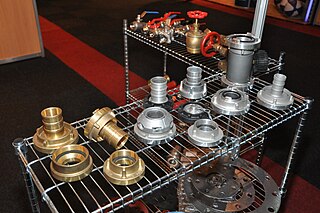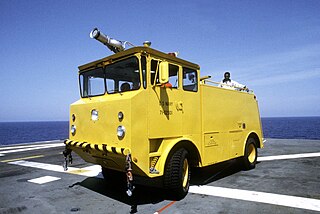This article needs additional citations for verification .(September 2014) |
A hydrant wrench is a tool used to remove fire hydrant caps and open the valve of the hydrant. They are usually adjustable so as to fit different sized hydrant nuts.
This article needs additional citations for verification .(September 2014) |
A hydrant wrench is a tool used to remove fire hydrant caps and open the valve of the hydrant. They are usually adjustable so as to fit different sized hydrant nuts.

In France, The wrench is called "Guillemin wrench" (French : clef Guillemin, pronounced [kleɡijəmɛ̃] ), but the firefighters call it "tricoise wrench" (clef tricoise, [kletʁikwaz]). The curved part applies on the ring, and the hooked part clutches a notch.
Big tricoise wrenches are placed in fire trucks, and are mainly used to fasten the big hoses, e.g. ∅110 mm hoses to feed the pumper tank from the hydrant (∅100 mm for the clutch). Small tricoise are made of brass and hang at the fire belts; they are used to fasten the small hoses, e.g., ∅70mm to ∅22mm hoses (∅65mm to ∅20mm clutches).
The shape is sometimes adapted so it can be used as a tool for other purposes; it is then called "polycoise wrench" or "Deschamps wrench". These tools are used to


The shape of a hydrant wrench is sometimes adapted so it can be used as a tool for other purposes, such as:

Elmira Heights is a village in Chemung County, New York, United States. The population was 4,097 at the 2010 census. The village is primarily within the town of Horseheads, but part of the village is in the town of Elmira. The village is a northern suburb of the city of Elmira. It is part of the Elmira, New York Metropolitan Statistical Area.

A fire hose is a high-pressure hose that carries water or other fire retardant to a fire to extinguish it. Outdoors, it attaches either to a fire engine, fire hydrant, or a portable fire pump. Indoors, it can permanently attach to a building's standpipe or plumbing system.

A wrench or spanner is a tool used to provide grip and mechanical advantage in applying torque to turn objects—usually rotary fasteners, such as nuts and bolts—or keep them from turning.

A fire hydrant, fireplug, firecock (archaic), hydrant riser or Johnny Pump is a connection point by which firefighters can tap into a water supply. It is a component of active fire protection. Underground fire hydrants have been used in Europe and Asia since at least the 18th century. Above-ground pillar-type hydrants are a 19th-century invention.

A tap is a valve controlling the release of a fluid.

Storz is a type of hose coupling invented by Carl August Guido Storz in 1882 and patented in Switzerland in 1890, and patented in the U.S. in 1893 that connects using interlocking hooks and flanges. It was first specified in standard FEN 301-316, and has been used by German fire brigades since 1933. Amongst other uses, it has been widely employed on fire hoses in firefighting applications. It is the standard coupling on fire hoses in Portugal, Denmark, Slovenia, Germany, Austria, Switzerland, Sweden, the Netherlands, Poland, Czechia, Israel, Croatia, Serbia, Bosnia & Herzegovina, Macedonia, Montenegro and Greece. It is also one of the standard couplings on fire hoses in Australia and the United States.

A socket wrench is a type of spanner that uses a closed socket format, rather than a typical open wrench/spanner to turn a fastener, typically in the form of a nut or bolt.
Firefighting jargon includes a diverse lexicon of both common and idiosyncratic terms. One problem that exists in trying to create a list such as this is that much of the terminology used by a particular department is specifically defined in their particular standing operating procedures, such that two departments may have completely different terms for the same thing. For example, depending on whom one asks, a safety team may be referred to as a standby, a RIT or RIG or RIC, or a FAST. Furthermore, a department may change a definition within its SOP, such that one year it may be RIT, and the next RIG or RIC.

A screw thread is a helical structure used to convert between rotational and linear movement or force. A screw thread is a ridge wrapped around a cylinder or cone in the form of a helix, with the former being called a straight thread and the latter called a tapered thread. A screw thread is the essential feature of the screw as a simple machine and also as a threaded fastener.
This is a glossary of firefighting equipment.

A hose coupling is a connector on the end of a hose to connect it with another hose or with a tap or a hose appliance, such as an irrigation sprinkler. It is usually made of steel, brass, stainless steel, aluminium or plastic.

A fitting or adapter is used in pipe systems to connect sections of pipe or tube, adapt to different sizes or shapes, and for other purposes such as regulating fluid flow. These fittings are used in plumbing to manipulate the conveyance of fluids such as water for potatory, irrigational, sanitary, and refrigerative purposes, gas, petroleum, liquid waste, or any other liquid or gaseous substances required in domestic or commercial environments, within a system of pipes or tubes, connected by various methods, as dictated by the material of which these are made, the material being conveyed, and the particular environmental context in which they will be used, such as soldering, mortaring, caulking, plastic welding, welding, friction fittings, threaded fittings, and compression fittings.

Flexible suction hose, not to be confused with hard suction hose in U.S., is a specific type of fire hose used in drafting operations, when a fire engine uses a vacuum to draw water from a portable water tank, pool, or other static water source. It is built to withstand vacuum, rather than pressure, abrasion, and heat. Conversely, hard suction is capable of withstanding up to 200 PSIG, as well as vacuum. In the United States, it is standard equipment according to the National Fire Protection Association standards for fire engines. It is used in both structural and wildland firefighting throughout the world, and is made in various diameters and connection types.
Multi-jackbolt tensioners (MJT) are an alternative to traditional bolted joints. Rather than needing to tighten one large bolt, MJTs use several smaller jackbolts to significantly reduce the torque required to attain a certain preload. MJTs range in thread sizes from 3⁄4 in (19 mm) to 32 in (810 mm) and can achieve 20 million pounds-force or more. MJTs only require hand-held tools, such as torque wrenches or air/electric impacts, for loading and unloading bolted joints.
For hoses and piping, a quick connect fitting, also called a push fitting, is a coupling used to provide a fast, make-or-break connection of gas or liquid transfer lines. Operated by hand, quick connect fittings replace threaded or flanged connections, which require wrenches. When equipped with self-sealing valves, quick connect fittings will, upon disconnection, automatically contain any fluid in the line.

Dixon Valve & Coupling Company, LLC is a manufacturer and supplier of hose fittings and accessories. The company, often referred to as just Dixon, offers products for fire protection, food processing, dairy processing, beverage and brewery operations, industrial manufacturing, mining, construction, chemical processing, petroleum processing and refining, oilfields, mobile tankers and agricultural operations. Dixon Valve, which was founded by H. W. Goodall in 1916, maintains manufacturing, warehouse, sales or service facilities in eleven U.S. states. It also has sales and service offices on five continents. Its international headquarters are in Chestertown, Maryland (USA).

A DSP coupling is a self-sealing symmetrical coupling which is secured by inter-connecting two couplings together.
Despite fire hose and hydrant coupler standardization efforts that are at least 144 years old, there remain significant areas in Canada, the United States, and Mexico that use fire hose and hydrant threads and other couplings that are incompatible with those used by neighboring fire departments. This is notable because the first fire hydrant was invented by Manhattan fire fighter George Smith in 1817, making these devices 200 years old.

The Oshkosh MB-5 is a specialized aircraft rescue and firefighting (ARFF) vehicle built by Oshkosh Corporation for putting out fires on-board aircraft carriers. It was designed for rapid deployment of multiple firefighting media by a crew of 4, with a relatively compact design. However, What set this truck apart from other ARFF vehicles of the time was its ability to pump water while moving. This feature, along with its powerful 10.7 L Caterpillar diesel engine and four-wheel drive, made the MB-5 a staple of US military firefighting. It could be seen on US aircraft carriers and airbases both during and after the Vietnam War, continuing service for almost a decade after production of the truck stopped in late 1971 (unconfirmed).